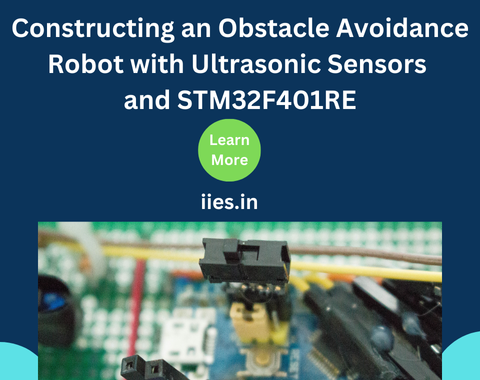
One essential feature that enables mobile robots to safely traverse environments is obstacle avoidance. The STM32F401RE microcontroller and an ultrasonic sensor (like the HC-SR04) will be used to construct an obstacle avoidance robot in this tutorial. A strong ARM Cortex-M4 microcontroller with cutting-edge features and accessories, the STM32F401RE is a great option for robotics projects. Because ultrasonic sensors use high-frequency sound waves to measure distance, they are perfect for spotting obstacles.
Overview of the Project
The project’s objective is to build a mobile robot that can recognize obstacles in its path and move around them on its own. Obstacles in front of the robot will be detected by the ultrasonic sensor. The robot will take corrective action (such as turning left or right) to avoid obstacles if it detects them too close.
STM32F401RE: The brain of the robot is the STM32F401RE microcontroller.
HC-SR04: The HC-SR04 To measure distance, an ultrasonic sensor is employed.
DC motors and a motor driver: To regulate the robot’s motion.
Chassis: Used to put the robot’s parts together.
Power Supply: The robot is powered by a battery or a USB connection.
You must prepare your development environment before you start: Set up the STM32CubeIDE:
The HC-SR04 ultrasonic sensor has four pins:
VCC: Attach to 5V (or, if opting for a low-voltage version, 3.3V).
Trig: The trigger pin, which the STM32 controls, is used to send the pulse to the sensor.
Echo: The echo pin, which is connected to an STM32 input pin, receives the reflected pulse. Ground is GND. Regarding the motor driver: To regulate the direction of the DC motors, connect the IN1, IN2, IN3, and IN4 pins to the STM32’s GPIO pins.
Connect VCC to the battery’s positive terminal and GND to the ground.

The following steps are part of the core logic: The ultrasonic sensor is activated by sending a pulse to the Trig pin, which causes the sensor to release an ultrasonic wave. After bouncing off obstructions, this wave returns to the Echo pin, where the received signal’s duration can be calculated.
Distance Calculation: The distance to the obstacle is calculated using the following formula based on the time it takes for the signal to return:


You can test your robot after connecting the hardware and uploading the code to the STM32F401RE:
Initial Testing: Make sure the robot’s motors and ultrasonic sensor function as intended by placing it in an open area.
Obstacle Detection: Position obstacles at different distances in front of the sensor and make sure the robot modifies its motion appropriately.
Fine-tuning: To improve performance, change the turning logic or the threshold distance (for example, 20 cm).
In this project, we used the STM32F401RE and the HC-SR04 ultrasonic sensor to build a basic obstacle avoidance robot. We’ve looked at wiring the parts, configuring the development environment, and writing the code for the robot’s self-navigating capabilities. Now that you have this base, you can experiment with more sophisticated features to enhance the functionality of your robot.
The STM32F401RE is a good fit for many kinds of robotic devices. The following robotics applications are where this microcontroller excels:
Real-time control and sensor data processing are essential for robots that navigate in real-world settings, like drones and driverless cars. The STM32F401RE effectively manages motor control, sensor fusion, and intricate navigation algorithms. The STM32F401RE can interface with a variety of sensors (such as ultrasonic, LIDAR, and IMU) and control motors for accurate movement using interfaces like SPI, I2C, and PWM.
Robots frequently have to carry out repetitive tasks in industrial automation, such as picking, placing, and assembling. These industrial robots are best controlled by the STM32F401RE because of its precise motor control capabilities, I/O flexibility, and real-time performance. It is the ideal option for robotic arms and other industrial machines due to its versatility in terms of integrating with different sensors and actuators.
Robots that help with cleaning, delivery, or medical care can benefit from the STM32F401RE’s rich peripheral set, low power consumption, and real-time performance. The microcontroller can operate motors, control sensors (such as cameras and ultrasonic), and run decision-making algorithms to avoid obstructions and communicate with people.
The STM32F401RE provides students and robotics enthusiasts with an accessible and reasonably priced learning platform. It enables enthusiasts to construct a wide range of robots, from basic line-following machines to more intricate autonomous machines. The flexibility required to experiment with various robotic concepts is provided by the microcontroller’s peripheral interfaces and processing power.
Indian Institute of Embedded Systems – IIES